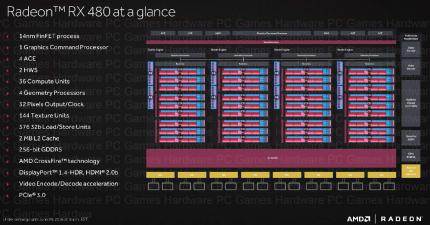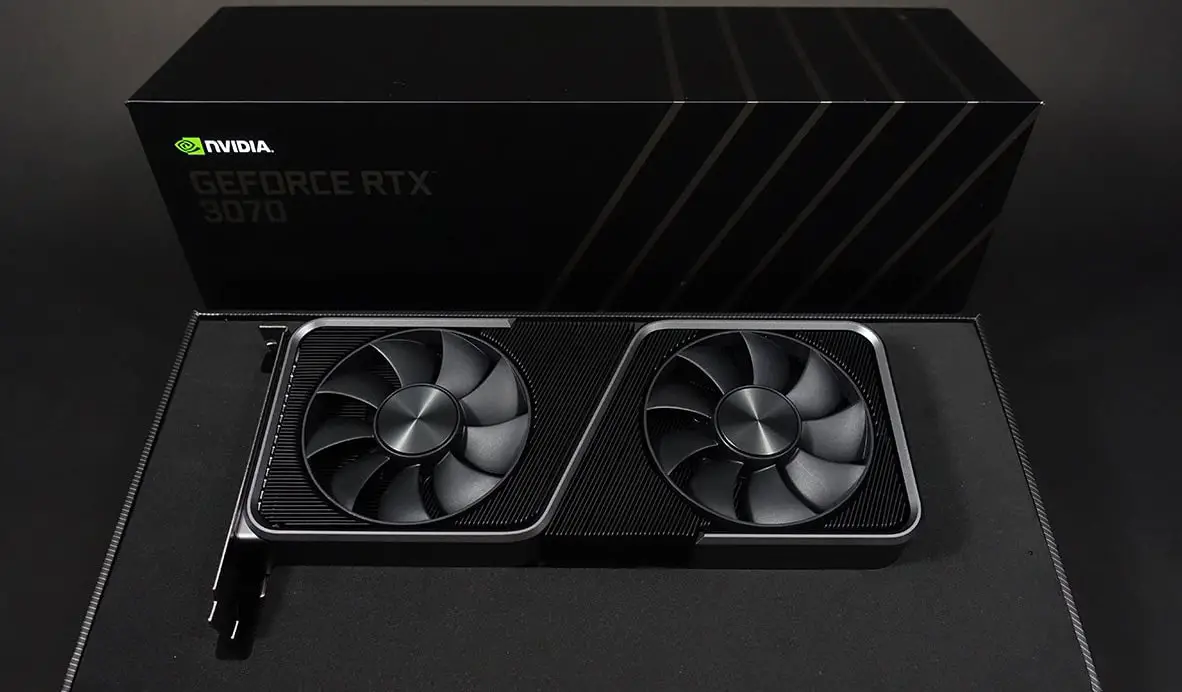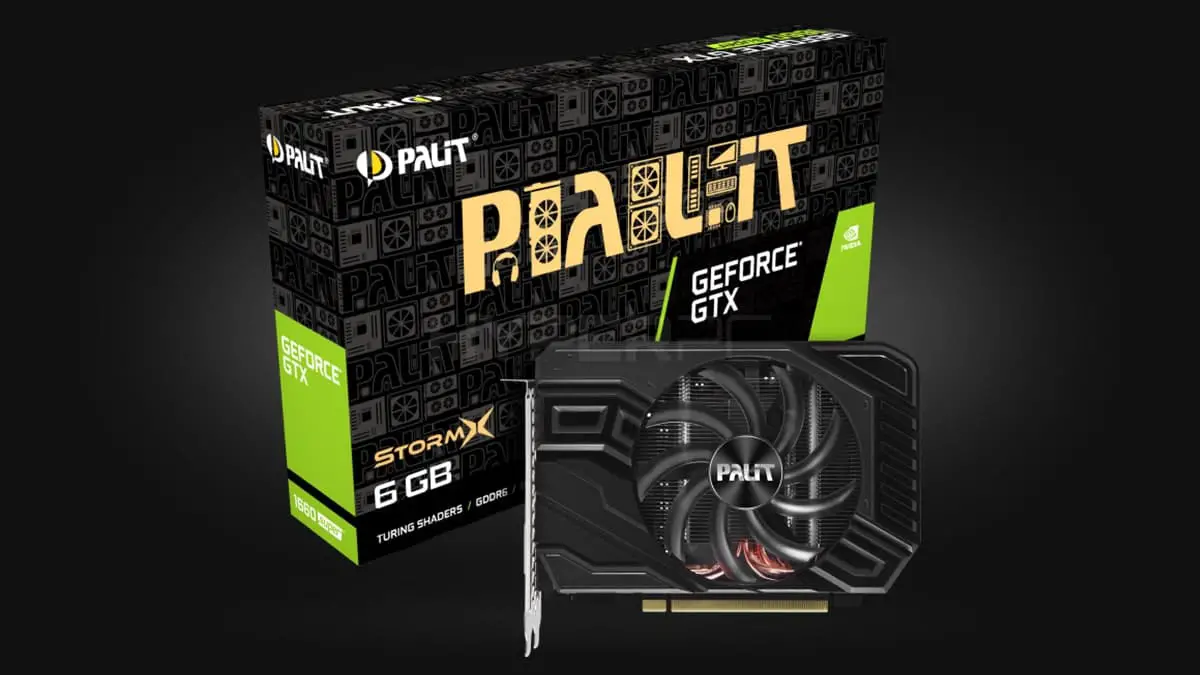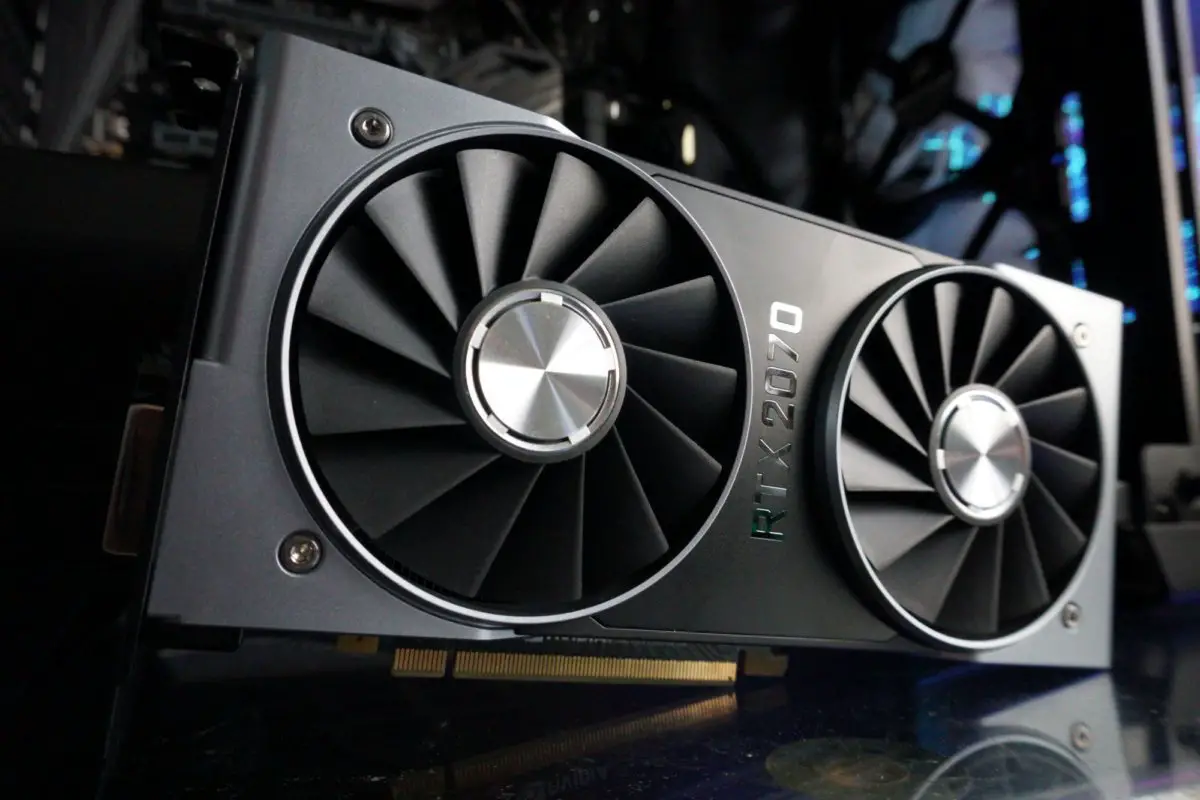Radeon RX 480 (8 GiB): Test | Benchmark| Power Consumption With the Radeon RX 480, AMD is ringing in a new era: Not only is its motor, the Polaris P10 GPU, the first graphics chip with energy-saving 14 nm technology, at the same time AMD wants to meet the Steam and Oculus VR performance recommendations for virtual reality also open up this market to a wide audience:
The Radeon RX 480 is said to be in the 8 GiByte version for around 255 euros and in the 4 GiByte version (with a 12.5% lower memory clock) for a slim 215 Euro come on the market. Initially, only the reference design tested here is available with 8 GiB, 4 GiB and partner variants are to follow from mid-July.
We chase the Radeon RX 480 through our benchmark course and let it compete against a number of selected comparison models: A wide selection is represented, from cards with comparable prices to earlier generations to overclocked Radeon and Geforce models.
The predecessor cards and Geforce models with comparable prices are preselected in our game benchmarks (more can be added!). The whole thing is garnished with a few theoretical tests on throughput rates, compute performance and more. There are also our proven measurements for loudness in low-noise rooms and for directly measured power consumption in various scenarios.
12:16
Radeon RX 480 meets Accelero Mono Plus: Polaris 10 quietly overclocked to 1,350 / 4,500 MHz
AMD Radeon RX 480 (8 GiB) in the test: Specifications
The rough specifications have been known for weeks – AMD presented them about a month ago at Computex. The Polaris P10, the larger of the two new chips, is said to be available from US $ 199, offer more than 5 TFLOPS of computing power and achieve up to 2.8 times as high performance per watt compared to selected products of the previous generation – that’s how it became communicated by AMD on June 13th.
According to the footnotes of the AMD document, this comparison was based on the comparison of the TDPs of an RX 480M (35 watts) with an R9M 280X (82 watts) based on 3DMark results. At the launch of the RX 480, i.e. the desktop card, AMD only speaks of 90 percent better energy efficiency of the RX 480 compared to an R9 290 in the Reviewer’s Guide – again based on the “typical gaming power” of 150 watts, but at least under gaming load. We will see later what this is important in practice.
According to AMD, the Polaris P10 will be 232 mm² in size and contain 5.7 billion transistors. 36 compute units á 4 × 16 SIMDs (i.e. 2,304 shader ALUs) do the arithmetic work, 144 texture units beautify games and 32 raster output stages on a 256-bit wide memory interface complete the functional units in a rough overview.
The AMD hardware DirectX 12 still fulfills feature level 12_0 , the rasterizer that has not been drilled out prevents Polaris 10 from FL12_1 compliance. As a result, few or no disadvantages are to be expected: The current and upcoming console generation are based on comparable AMD hardware and thus represent the common denominator for the majority of cross-platform developments.
In detail, AMD has incorporated numerous innovations into the Polaris generation. Well-known technologies have been improved in their efficiency, caches such as the instruction buffer or the L2 cache have been enlarged and new function blocks have been added – all within the scope of the maxim of performance per watt.
New for an AMD GPU is the Adaptive Voltage & Frequency Scaling adopted from the Carrizo APUs, in which the optimal curve from clock and voltage is found for each individual chip and the possible performance is to be optimized in this way. The quad-bit flip-flops, which are intended to ensure more efficient distribution and maintenance of the clock signal over the entire chip, also belong in this area. 21 million of these elements are built into the Polaris P10 and they influence 15 percent of the ASIC TDP – with a savings effect of 4-5 percent, according to AMD.
Apropos ASIC-TDP: Attentive readers may have noticed in one or the other leaked GPU-Z screenshot that there is a new ad called “GPU Power Draw”. At AMD, these are currently only available for Polaris. Contrary to the rumors that the Polaris P10 would only need 110 watts on average, it actually only shows the consumption of the GPU – plus converter losses, the memory chips and other things.
AMD confirmed to us that the pure ASIC power for the RX 480 is specified with 110 watts. However, due to the way Powertune works, short excursions (peaks) beyond this are still possible. In total, you get a little more than 150 watts, whereby both the 12-volt lines of the PEG slot and the 6-pin plug are almost completely used, sometimes even slightly overloaded. AMD is of the opinion that the PCI-E specification allows this leeway.
Also the performance per compute unitwants AMD to have improved. In the documents available to us, the manufacturer speaks of an increase of up to 15 percent and cites in its calculation bases the comparison of RX 480 with R9 290 already mentioned above, which on average is based on AotS, GTA 5, Project Cars, Witcher 3, AC: Syndicate 52, 14 fps to 50.06 fps for the RX 480.
What is missing for a meaningful comparison for the increase in performance per CU are adjusted clock rates, as AMD confirmed when we asked. The calculation of the better performance per bit for the memory interface compared to the R9 290 is also on a comparatively sluggish footing: the performance per bit is said to have increased by 40 percent thanks to the now 2 MiByte L2 cache – but the transfer rate alone is 8 vs. 5 GT / s up 60%. Here, too, it is not entirely clear to us what AMD is trying to say.
00:51
Radeon RX 480: AMD video shows technical data
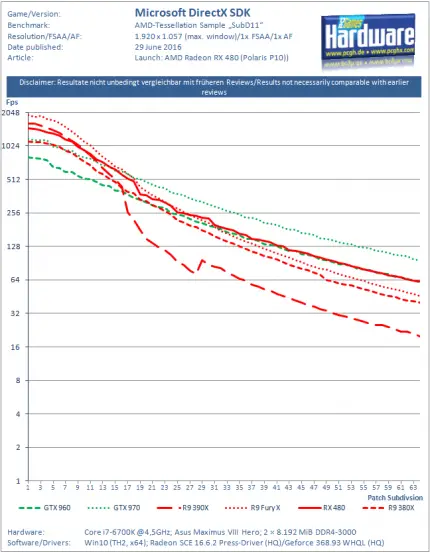
Radeon RX 480: Tessellation performance
Source: PC Games Hardware
Completely new, however, is a hardware unit called the Primitive Discard Accelerator . Here triangles that are less than 1 pixel in size in the later picture are discarded before they can block further resources in the pipeline. The PDA should be able to show its advantages especially when using tessellation and multisample AA. This is very noticeable in our tessellation test, where the RX 480 overtakes the Fury X with factors of 27 and more and in the end gains a lead of up to 42% percent, which is twice as high as its pure clock advantage. Compared to an R9 390X, the RX 480 is around three times as fast here!
Nerd-Gasm: With around 24.57 million transistors per square millimeter, AMD achieves around 7 percent higher packing density than Nvidia with the Pascal GP104 (22.93 million / mm²) despite the smaller GPU (usually with a lower transistor density than larger models). Compared to the best-positioned predecessor of the 28 nm generation in-house, the Fiji GPU with 14.93 million / mm², the P10 is 64.6% ahead, compared to a chip of comparable size like Pitcairn by around 86% ! Only Nvidia’s giant GPU from the professional sector, the GP100, has to admit defeat in this respect with a 2% deficit in the transistor density. Fun fact: The very first Geforce from 1999 had a number of transistors of 23 million and in 14/16 nm production would theoretically fit into a single square millimeter, a Radeon 256 with 30 million.
| model | Geforce GTX 970 | Geforce GTX 1070 | Geforce GTX 1060 6GB | Radeon RX 480 | Radeon R9 380X | Radeon R9 390X | Radeon R9 Nano |
|---|---|---|---|---|---|---|---|
| Codename | GM204-200 | GP104-200 | GP106-400 | Polaris P10 | Tonga XT | Hawaii XT | Fiji LP |
| production | 28 nm TSMC | 16 nm FinFET TSMC | 16 nm FinFET TSMC | 14 nm FinFET Samsung/GloFo | 28 nm TSMC | 28 nm TSMC | 28 nm TSMC |
| DX-12-Feature-Level | 12_1 | 12_1 | 12_1 | 12_0 | 12_0 | 12_0 | 12_0 |
| Chip size (pure die) | 398 mm² | 314 mm² | 200 mm² | 232 mm² | 359 mm² | 438 mm² | 596 mm² |
| Transistors graphics chip (million) | 5.200 | 7.200 | 4.400 | 5.700 | 5.000 | 6.200 | 8.900 |
| Shader-/SIMD-/Textureinheiten | 1.664/13/104 | 1.920/15/120 | 1.280/10/80 | 2.304/36/144 | 2.048/32/128 | 2.816/64/176 | 4.096/64/256 |
| Raster output stages (ROPs) | 56 | 64 | 48 | 32 | 32 | 64 | 64 |
| GPU Base Rate (Megahertz) | 1.050 | 1.506 | 1.506 | 1.120 | unknown | unknown | unknown |
| GPU-Boost-Takt (Megahertz) | 1.178 | 1.683 | 1.708 | 1.266 | 970 | 1.050 | 1.000 |
| Computing power SP / DP (billion / s) * | 3.920/123 | 6.463/202 | 4.373/137 | 5.834/365 | 3.973/248 | 5.913/739 | 8.192/512 |
| Throughput pixels / texels (billion / s) * | 61,3/122,5 | 80,8/202,0 | 54,7/136,6 | 40,5/182,3 | 31,0/124,2 | 67,2/184,8 | 64,0/256,0 |
| Memory connection (bit) | 224 + 32 | 256 | 192 | 256 | 256 | 512 | 4.096 |
| Graphics memory speed (GT / s) | 7,0 | 8,0 | 8,0 | 8,0** | 5,7 | 6,0 | 1,0 |
| Memory transfer (GB / s) | 196+28*** | 256 | 192 | 256 | 256 | 384 | 512 |
| Usual memory amount (MiB) | 3.584 + 512*** | 8.192 | 6.144 | 8.192** | 4.096 | 8.192 | 4.096 |
| PCI-Express-Stromanschlüsse | 2 × 6-pin | 1 × 8-pin | 1 × 6-pin | 1 × 6-pin | 2 × 6-pin | your 1 × 6-/8-pin | 1 × 8-pin |
| Typical power consumption according to the manufacturer | 120 Watt | 150 Watt | 190 Watt | 250 Watt | 175 Watt |
** Based on the boost / max. Clock rate ** 4 GiB models factory-set with 3.5 GT / s memory speed (224 GB / s) *** memory segmentation, see PCGH 04/2015
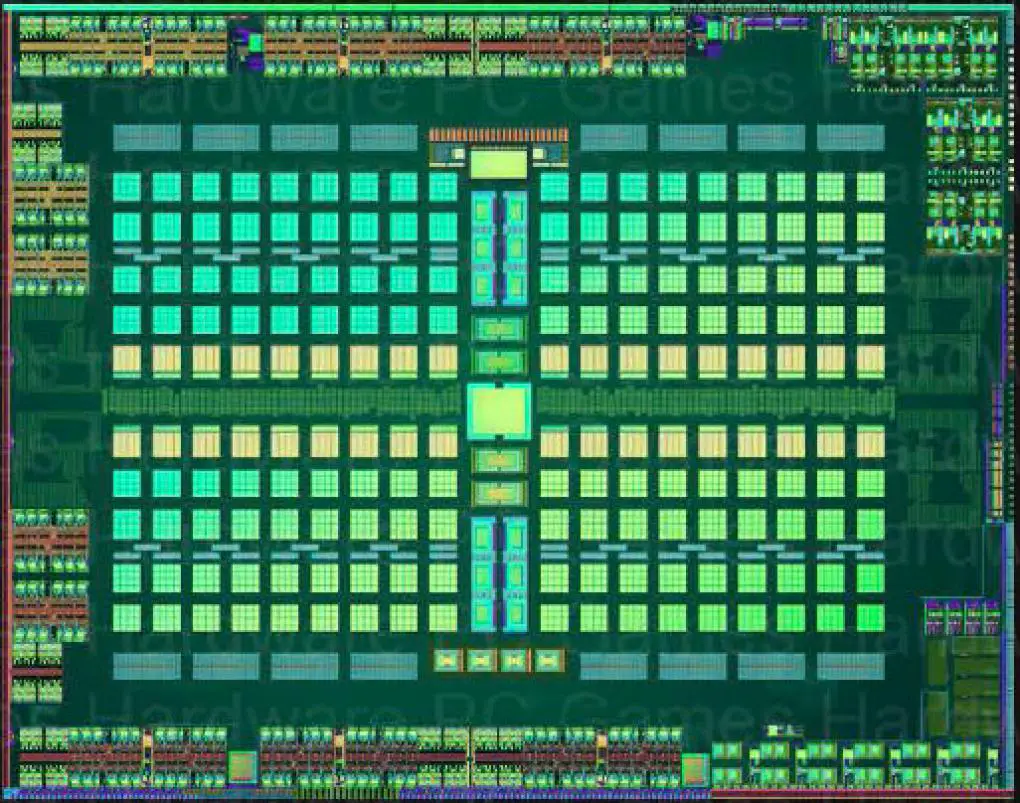
Polaris P10: The Shot
Source: AMD
AMD Radeon RX 480 (8 GiB): Expectations – Hype vs. Reality
As with almost every graphics card launch, especially a new generation, expectations have been raised by more or less random leaks and information blocks. This led to the fact that, due to the extremely good performance of the RX 480 in the GT4 of 3DMark 11 in the performance preset, some users assumed that the RX 480 would match the Radeon R9 Fury or even the R9 Fury despite its announced low price X could accommodate.
AMD’s own classification of the product contradicts this expectation. Even against an R9 390X, AMD does not rank the RX 480 in its own Reviewer’s Guide. Instead, the performance is compared with that of an R9 380X and a GTX 970. While the RX 480 is consistently ahead of its in-house predecessor, as expected, the 1440p performance picture looks mixed, especially under the currently more widespread DX11 interface: In 7 of 12 tests, the RX 480 lags behind the much criticized memory segmentation that was not disclosed at the launch , but nonetheless widespread GTX 970. Mind you in AMD’s own benchmarks! In the DX12 tests, however, AMD sees its RX 480 consistently ahead of the GTX 970. How the RX 480 fares in the PCGH benchmarks
AMD Radeon RX 480: display engine with H.265, VP9, HDR and DP1.2-1.4
AMD has also completely redesigned the display and video engine – perhaps even more so than the shader core. The Radeon RX 480 masters the Displayport protocol in version 1.4, HDMI 2.0b and can therefore draw on a multitude of combinations of ultra-high resolution, HDR color space and high refresh rates. Here is an exemplary selection:
- 1080p with up to 240 Hertz (SDR / HDR)
- 1440p with up to 240 Hertz SDR and 170 Hertz HDR
- 1440p with up to 190/144 Hertz SDR / HDR at 3,440 pixels image width (21: 9)
- 2160p with up to 120 Hertz SDR or 60 Hertz in HDR mode
- 2880p with up to 60 Hertz over a single cable
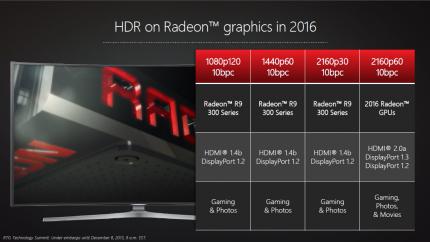
Source: AMD
The video encoder and decoder has also massively increased in capabilities: H.264 and HEVC / H.265 are accelerated in hardware The focus is clearly on HEVC: Polaris offers 1080p240, 1440p120 opder 4K60 for encoding , with H.264 only half the frame rate.
When it comes to decoding, Polaris also clearly beats its predecessors: HEVC with 4k60 in the Main 10 profile, which includes 10 bit color depth per channel, VP9 is decoded up to 4K resolution, MJPEG up to 4K30, H.264 up to 4K120 MP4-P2 and VC1 up to 1080p60. So far only Fiji could keep up and the HDR capability for HEVC was missing.
Also new is a 2-pass encoder, which is offered for H.264 and HEVC and is said to bring advantages of up to 1 dB Y-PSNR (signal-to-noise ratio), especially for fast scene changes. This is particularly interesting for streamers who bring fast PC games to Twitch or Youtube. In December last year, we already reported in detail on the subject of the display engine at AMD Polaris.
AMD Radeon RX 480 (8 GiB) in the test: loudness, power consumption, cooling
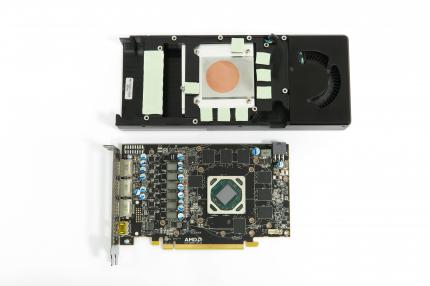
Source: PC Games Hardware
If you choose a Radeon RX 480 from June 29th, you will automatically use the AMD reference design. With its 17.8 centimeter short circuit board, the radial fan protruding above the PCB and the plastic cover, it is strikingly reminiscent of Nvidia’s Kepler models Geforce GTX 660/670. A relatively compact aluminum radiator with an enclosed copper base is responsible for cooling the GPU; there are no heat pipes at all. A solid metal frame covers both the graphics memory and the six-phase power supply. The latter is not, as is usual with most graphics cards, at the rear of the board, but near the display outputs – the Radeon models HD 6870 and HD 6850 released in 2010 send a warm greeting.
The operating noise of the RX 480 is appropriate for a reference design of the middle class. When idling, the cooler produces a quiet but “pithy” hum that corresponds to a loudness of 0.3 sone (19% PWM) – this is difficult to hear from a closed case. As a result, AMD, like Nvidia, does without an operating mode with standing fans – the partner manufacturers will implement this with their designs. When under load, the GPU, which is initially around 35 ° C, heats up to 84 ° C and the automatic fan control runs at a maximum of 58 percent performance (around 2,250 rpm). The loudness in this state is 3.3 sons.
The Radeon RX 480 always ranks just below the 160 watt mark in games.
The power consumption, which we measure using the PCI-E extender, leaves us with mixed feelings. The RX 480 achieves relatively constant results under load: Regardless of whether it is Crysis 3 in Full HD, Risen 3 Enhanced Edition in WQHD or Anno 2070 in Ultra, the Radeon RX 480 always ranks just below the 160 watt mark. Although this fits the AMD specification of “typical” 150 watts, it is more than expected in view of the refined production and the clock rate that has barely increased compared to previous GCN cards. The fluctuations in the PEG slot make us pensive: The RX 480 / 8G we have before us regularly “peaks” beyond the 75 watt specification of the interface and could therefore overwhelm motherboards built in the borderline area. AMD partners can easily avoid this problem,
Our Radeon RX 480 sample consumes around 15 watts of energy in idle. This is good and less than most older Radeon graphics cards, but Nvidia’s Pascal models GTX 1080 and GTX 1070 are well below the 10 watt mark. While this observation is hardly worth the money, another one does it very well: Both during our video tests, for which we play a Youtube clip in Ultra HD and measure the power consumption, as well as with two connected (different) displays, the Radeon fires RX 480 / 8G their memory with a full 4,000 MHz. The resulting power consumption is around three times as high as that in absolute idle.
Last-minute information directly from AMD: The high idle power consumption is due to a bug that prevents the RX 480 from adopting its lowest power state. Realistically, the idle power consumption can be expected to drop by around a third as soon as the bug has been fixed with a driver update. ETA: When it’s done.
Incidentally, our Radeon RX 480 sample only shows coil whine from high three or even four-digit frame rates, provided that a suitable 3D load is present. The noise can be provoked on almost all high-performance graphics cards – we have already reported in detail about the causes and consequences in the issue 01/2015 – and in the case of the RX 480, its level is on par with other reference cards from AMD and Nvidia.
| volume | GTX 1080 | GTX 1070 | GTX 1060 | RX 480 | GTX 980 | GTX 980 Ti | R9 Fury X | R9 290X ‘Uber’ |
|---|---|---|---|---|---|---|---|---|
| Idle (Windows Desktop) | 0.4 Zone | 0.4 Zone | 0.5 Zone | 0.3 Zone | 0.3 Zone | 0.3 Zone | 1.4 Zone | 0.6 Zone |
| Year 2070 (3,840 × 2,160) | 3.2 Zone | 2.9 Zone | 2.4 Zone | 3.3 Zone | 3.0 Zone | 4.5 Zone | 1.7 Zone | 9.6 Zone |
| Risen 3 EE (2.560 × 1.440) | 4.2 Zone | 2.7 Zone | 2.3 Zone | 3.3 Zone | 2.7 Zone | 4.5 Zone | 1.7 Zone | 9.6 Zone |
| Power consumption | ||||||||
| Idle (Windows Desktop) | 9,5 Watt | 8,5 Watt | 6,5 Watt | 15 Watt | 12 Watt | 15 Watt | 21 Watt | 21 Watt |
| Crysis 3 (1.920 × 1.080) | 175 Watt | 149 Watt | 116 Watt | 157 Watt | 165 Watt | 230 Watt | 250 Watt | Not measured |
| Year 2070 (3,840 × 2,160) | 171 Watt | 148 Watt | 120 Watt | 160 Watt | 163 Watt | 234 Watt | 313 Watt | 289 Watt |
| Risen 3 EE (2.560 × 1.440) | 175 Watt | 146 Watt | 119 Watt | 158 Watt | 160 Watt | 236 Watt | 329 Watt | 269 Watt |
RX 480: Overclocking-Test mittels “Wattman” …
AMD markets the Polaris family as energy efficient graphics cards. In addition, owners of a corresponding model can slip into the role of Wattman, the avenger of the underclocked. Wattman is the name of the tuning menu in the Radeon driver, formerly known as Overdrive. When asked by PC Games Hardware, AMD confirmed that older Radeon graphics cards will soon be able to use the extended range of functions, but did not specify either the supported models or the time period.
In addition to the almost obligatory controls for the core and memory clock, there is also the option of specifically adapting the eight power states of the GPU. Tuners focus directly on State 7 and can increase both the clock rate and the core voltage there. Unfortunately, AMD sets tight limits to the game with voltage, we are not allowed to spend more than 1.15 volts on our Radeon RX 480. In the case of the cost-optimized reference design, this makes sense to us – we are curious to see which options the upcoming partner cards will offer. Of course, the GPU can also be undervolted here to make it quieter; this works best with the help of self-defined settings for temperature target and ventilation. The latter could be set a little imprecisely with our press driver 16.6.2,
RX 480: retrofit cooling
After all tests were completed, we dismantled the reference cooler and got up close and personal with the RX 480 with various retrofit coolers. Our goal was to significantly increase the cooling performance without letting the dimensions of the compact card get out of hand, so Raijintek Morpheus (2), Arctic Accelero Xtreme IV & Co. were out of the question.
Our first choice, the venerable Thermalright Shaman, cannot be mounted on the RX 480 due to the heat pipes colliding with the coils – the cooler’s coldplate is a few millimeters higher than the GPU die. On the other hand, the Arctic Accelero Mono Plus, which is still available (from around 28 euros), fits perfectly. It only extends the card by a few centimeters in length, but increases the space required on the mainboard to effectively four slots. We will publish an article shortly with the exact results of this rebuild. Until then, the following video will provide you with initial information about the Radeon RX 480 and the Accelero Mono Plus:
12:16
Radeon RX 480 meets Accelero Mono Plus: Polaris 10 quietly overclocked to 1,350 / 4,500 MHz
Last, but not least, a few OC values with unchanged reference cooling: With maximum voltage in the Radeon Wattman, 150 percent power limit and ventilation increased to 80% PWM pulse, 1,300 MHz core and 4,500 MHz memory clock can be used stably. As a result, the RX 480’s frame rate increases by 10 to 21 percent. After these promising percentages, it is high time for Fps values. These are just a click away on the next article page.
Alle Leser bekommen bei uns täglich kostenlos News, Artikel, Guides, Videos und Podcasts über aktuelle Spiele-Hardware und ihre Lieblingsspiele. Bislang haben wir diese Seite vorwiegend über Werbung finanziert, doch seit COVID-19 wird das zunehmend schwieriger. Viele Unternehmen kürzen oder streichen für 2020 ihre Werbebudgets. Budgets, auf die wir leider angewiesen sind, wenn wir PC Games Hardware auch in Zukunft in gewohnter Form kostenlos anbieten wollen.
For this reason we turn to you now. As a PCGH supporter, you can support us so that we can continue to offer our known content in the usual form free of charge. Every contribution, large or small, is valuable. Supports PC Games Hardware – it only takes a minute.
The links marked with * are affiliate links. Affiliate links are not advertisements as we are independent in researching and selecting the products presented. We receive a small commission for product sales, which we use to partially finance the free content of the website.





